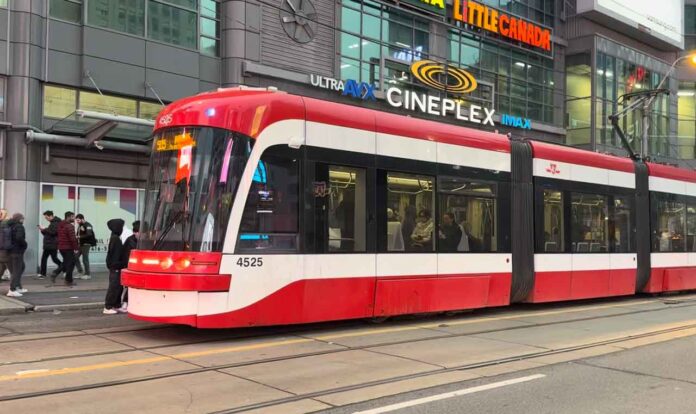Infra
Why a Two-Kilometre Strip of Yonge Street Has the Highest Life Expectancy in Toronto | The Local

At the edge of the city, where the northeastern terminus of Line 1 bridges the gap between Toronto and the rest of the GTA, is a long, skinny neighbourhood stretching from Finch Street to Sheppard Avenue. This narrow stretch of Yonge Street is lined almost exclusively with imposing condo buildings, erasing any notion of low housing density in the suburbs. At street-level, an overwhelming number of businesses crowd the sidewalks. Both locally owned mom-and-pop establishments and international chains provide seemingly endless options for the ample foot traffic. Many of these businesses cater to the immigrant population that lives in the neighbourhood: Korean bars slinging soju and tteokbokki, bubble tea shops with cutesy mascots smiling in the windows, and Iranian restaurants serving Persian classics all tempt passersby with sprawling patios that spill onto the wide sidewalk.
This is Yonge-Doris, where residents live the longest in Toronto. According to an analysis by The Local in collaboration with MAP Centre for Urban Health Solutions at St. Michael’s Hospital—the first ever neighbourhood-level look at life expectancy in Toronto—life expectancy at birth in Yonge-Doris is an impressive 86.2 years. That’s well above the city average of 80.9, and almost a dozen years higher than Moss Park, where the average resident lives to just 74.8. If Yonge-Doris were a country, it would have the highest life expectancy in the world, just slightly above Japan (Read more about The Local’s life expectancy analysis).
Only established as its own neighbourhood in 2022, after the city restructured its neighbourhoods for the first time in 25 years, Yonge-Doris is a little anomaly of a community—and not just because people here live for so long.
Jeff Chu, who has lived in a condo in the neighbourhood for more than 10 years with his wife and two children, loves it here because it has everything his family needs: access to diverse restaurants and grocery stores, a wealth of transit options, green spaces for the kids to play, and lots of public amenities. Though the family first moved to Yonge-Doris from the downtown core to be closer to Chu’s parents, they now love the neighbourhood’s proximity to just about everything they need to affordably lead an active, lively, and healthy life. “It’s hard to find all of these things in one kilometre,” says Chu. “[Yonge-Doris] has got to be one of the most desirable places to live.”
Moving south, the Yonge-Doris neighbourhood is a thin strip of condominiums on the east side of Yonge Street.
But why exactly do people in Yonge-Doris live so long?
“It’s always hard to attribute a phenomenon [like a high life expectancy] to any one specific thing,” says Dr. Andrew Pinto, a physician and scientist at the University of Toronto, and the director of the Upstream Lab at Unity Health Toronto. “Income, immigration status, transit and walkability, access to services, housing conditions…there are a lot of factors that come into play.”
Income is typically a major factor in overall health. A 2015 study from the City of Toronto found that men in the lowest income group were 50 percent more likely to die before age 75 than men in the highest income group. But wealth isn’t the entire story. Yonge-Doris residents are by no means the richest in the city—the neighbourhood’s median household income was just $73,000 in 2020, below the city average of $84,000. In fact, East Willowdale, filled with McMansions and cul-de-sacs immediately east of this strip of condos, has a median household income of $95,000, but a marginally lower life expectancy (84.6 compared to Yonge-Doris’s 86.2). Even people in the city’s wealthiest neighourhoods, like Rosedale and the Bridle Path, don’t live as long as Yonge-Doris residents.

What may set the neighbourhood apart is a less obvious marker of health: immigrants. According to 2021 census data, 64 percent of Yonge-Doris residents are immigrants (compared to Toronto’s 47 percent) and most of them are economic immigrants—that is, immigrants who were “selected for their ability to contribute to Canada’s economy.”
That demographic composition might point to a phenomenon called the “healthy immigrant effect” as one possible explanation for Yonge-Doris’s high life expectancy. Basically, for the first 10 or so years after someone moves to Canada, particularly in adulthood, their health tends to be better than someone who was born in Canada. There are a lot of theories for why this might be, but Pinto points to Canada’s rigorous points-based immigration process that “selects for people with sufficient income, professional credentials, existing resources and so on.” The factors for which the government assigns high points—from education to wealth to professional accomplishments—are also indicators of good health.
That effect, however, is not permanent. After about 10 years in Canada, immigrant health tends to decline and begins to resemble that of the Canadian population—or worse. “That could be because of linguistic barriers accessing health care, challenges with the job market, and things like systemic racism that they face, for example, not having their credentials recognized to maintain a higher income,” Pinto explains. In Yonge-Doris, tellingly, 23 percent of residents are new immigrants who arrived between 2011 and 2021—almost double the city-wide average.
Life Expectancy in Toronto
The first-ever neighbourhood-level analysis of life expectancy in Toronto reveals stark disparities across the city. Learn more about what this means for our city.

Related to the healthy immigrant effect is what’s called the “salmon effect.” Like salmon, many immigrants return to their place of origin as they age and their health declines, driving up the relative proportion of healthy immigrants, explains Yasmin Aboelzahab, a PhD candidate at the Leslie Dan Faculty of Pharmacy at the University of Toronto who studies how pharmacists can support newcomers and international students as they transition to the Canadian healthcare system. That complicates the healthy immigrant effect, and suggests that the Canadian healthcare system actually pushes out certain immigrants.
The neighbourhood’s diversity could be another one of the keys to its healthiness. In Yonge-Doris, 81 percent of residents are part of a visible minority, compared to Toronto’s 56 percent, with most of the immigrants coming from China, Iran, or South Korea, though newcomers from India and other places in Asia are increasingly also calling the neighbourhood home.
Both Aboelzahab and Pinto point to the neighbourhood’s large immigrant communities as a big reason residents are thriving. In Yonge-Doris, there are a number of resources dedicated to newcomers—ESL schools, newcomer centres, and services available at the public library, just to name a few. Other immigrants are an invaluable resource for newcomers, too, and moving somewhere where there are other people from your cultural background can ease the transition to a new country. Immigrants in Yonge-Doris can “easily connect with people who have come before them, and can share ideas on how to get ready for health issues they may experience,” says Aboelzahab. “This might be one of the reasons why, in an area with a lot of shared community knowledge, the healthy immigrant effect may be higher.”

An area with thriving newcomer communities will also draw more new immigrants to the area, and keep them there happily. “It can create a virtuous cycle where you have a number of immigrants coming to an area, establishing businesses and creating a more welcoming space for new people,” Pinto says. “It creates a thriving local economy and local business improvement in an area that is attuned to the needs of these communities.”
That was certainly true for 28-year-old Yonge-Doris resident Noushin Ziafati. When Ziafati and her family first lived in the area from 2009 to 2011, they loved living close to so many other Iranian families, having easy access to Iranian Plaza (a strip mall at Yonge and Steeles with a large number of Iranian businesses and restaurants) and the ability to participate in cultural events. “Every year for Iranian New Year, or other Iranian holidays, you could go celebrate in Mel Lastman Square,” says Ziafati, who moved back to the neighbourhood in 2021 after living on the east coast for a few years. “It’s one of the reasons I think my parents wanted to move here. They felt a bit more at home around their community.”
In addition to its thriving immigrant community, the neighbourhood also stands out for the sheer number of public services in the area. Pre-amalgamation, this area was developed in the ‘70s and ‘80s by former mayor Mel Lastman as the city of North York’s “downtown.” To create the “new downtown” he envisioned, Lastman concentrated a majority of North York’s municipal offices and services along this corridor on Yonge. Today, Yonge-Doris is home to a wealth of public resources like the massive North York Central branch of the Toronto Public Library, Mitchell Field Community Centre, Douglas Snow Aquatic Centre, three subway stations, a regional transit hub, and Mel Lastman Square, a public gathering space. Few other places in Toronto have this concentration of publicly-owned and accessible spaces and resources, all within a 30-minute walk.
Proximity to public spaces boosts the health of the residents, says Pinto, who calls publicly-funded buildings and spaces—libraries, parks, community centres—the “social infrastructure of our communities.” These are places that people can meet and connect with one another, but also where social services can be easily accessed. It’s what makes Yonge-Doris stand apart.
Webinar
Join us on Oct 10 for a virtual conversation with the researchers and journalists behind the first-ever analysis of life expectancy in Toronto neighbourhoods.

For Chu, the wealth of public services and spaces has been important for him and his family. With two young kids, Chu and his family love attending the weekly farmer’s markets, live music shows, and cultural events at the public square. It’s all a part of what makes their lives vibrant and fun. “All things considered, we’re fortunate to live in this neighbourhood,” Chu says. “Even the streets here are wider—like 50 percent wider than downtown.”
Yes, this stretch of Yonge is six-lanes wide, instead of the typical two or four farther south in the city (though there are proposals to transform Yonge and install medians, wider sidewalks, and bike lanes). But the rush of cars on Yonge is accompanied by wide sidewalks, superior walkability, and transit access. Walkscore, a website that ranks addresses and neighbourhoods based on how easily people can walk, bike, and use public transit, gives Yonge-Doris a 97/100 walk score. It’s a walker’s paradise, it says, and most errands don’t require a car. Similarly, with three TTC stations along this two-kilometre stretch, Yonge-Doris is a commuter’s dream. Most people in the neighbourhood live along Yonge, and many of these condos connect directly to the subway, making moving around the city via public transportation easy.
Housing is another reason this neighbourhood is an outlier. The majority of residents here are condo-dwellers—a whopping 92 percent of housing in this area is five storeys or taller, compared to the city-wide average of 47 percent. While much of the housing in this area is expensive, most of the buildings in the area were constructed pre-2018, meaning they’re rent controlled. Pinto points out that tenants who have lived in their homes for a long time have been able to keep their rents relatively affordable, compared to an area with exclusively new builds and no rent control.
Chu, for his part, bought his condo just over a decade ago. “Back then, condos were cheaper in North York. Still is, compared to downtown Toronto—and you get a lot more space,” Chu says. Another bonus: condos tend to have gyms and pools, which Chu says he and his neighbours use to stay fit and healthy.
And unlike neighbourhoods dominated by single-family homes separated by fences and lawns, residents in Yonge-Doris benefit from having to leave their private spaces for green space and other community amenities. “Housing that allows people to interact with one another really is key,” says Pinto.

When we look at places with lower life expectancy, Pinto says those neighbourhoods are likely the opposite of Yonge-Doris: “less transit, less walkability, less green space, less opportunity for local education and employment, longer distances for accessing healthy foods, far longer distances for accessing healthcare, and so on.”
In Yonge-Doris, strong infrastructure, a wealth of resources and support, numerous third spaces, and many—many—options for healthy food are all squished into this tiny two-kilometre stretch of Canada’s longest street. But, crucially, residents here live longer because their community enables them to. All this great social infrastructure allows people to develop strong, diverse social networks, and support each other to stay healthier as they age.
“It’s a picture of what a healthy area could be,” says Pinto. “Now my question is: How do we envision whole cities that have these characteristics, not just pockets?”
Correction—October 9, 2024: This article was updated to correct the age of Noushin Ziafati.








